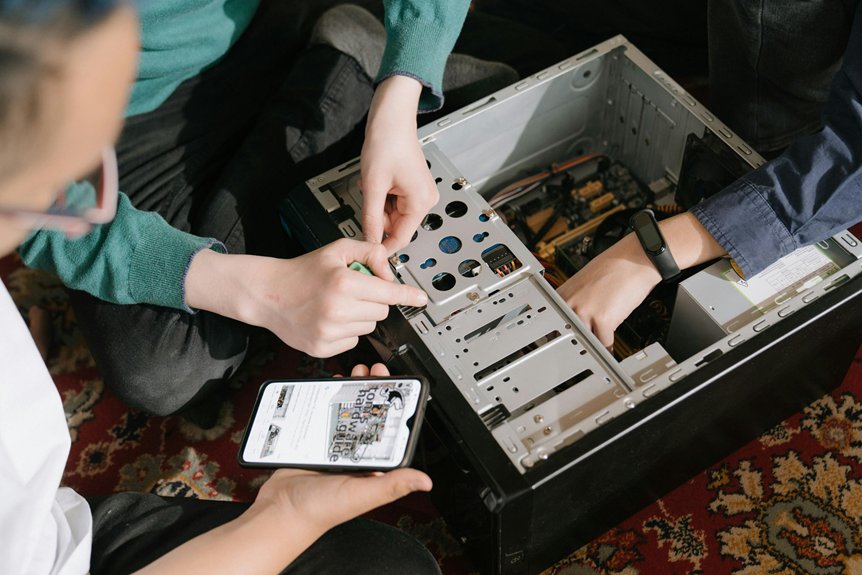If you’re a DIY enthusiast keen to tackle home maintenance tasks, there are essential courses that can enhance your skills considerably. From plumbing essentials to electrical wiring fundamentals, each topic offers practical knowledge you can apply immediately. Understanding painting techniques or carpentry skills can transform your living space. Ready to explore the top courses that will empower you to manage repairs and renovations efficiently? Let’s take a closer look at what each course has to offer.
Key Takeaways
- Online platforms offer comprehensive courses covering essential home repair techniques, including plumbing, electrical work, and appliance troubleshooting.
- Many courses emphasize safety protocols and best practices to ensure successful DIY projects without risk.
- Look for courses that include hands-on workshops or video tutorials for practical learning experiences.
- Courses often provide access to expert instructors who offer valuable insights and personalized guidance.
- Evaluate course reviews and ratings to select highly recommended options tailored to DIY enthusiasts’ needs.
Home Repair Basics

Home repair basics form the foundation of maintaining a safe and comfortable living environment. You need to grasp essential home maintenance techniques that prevent minor issues from escalating.
Start with routine checks—inspect your roof, gutters, and walls for damage. Familiarize yourself with repair techniques like patching drywall, fixing squeaky doors, and changing light fixtures.
Stock your toolbox with essential tools: a hammer, screwdrivers, pliers, and a level. Learn to troubleshoot common problems, and don’t shy away from online tutorials.
Plumbing Essentials
Understanding plumbing essentials is essential for any homeowner.
You’ll want to familiarize yourself with basic plumbing tools like wrenches and plungers, which are important for tackling common issues such as leaks and clogs.
Knowing how to address these problems not only saves you money but also boosts your confidence in home maintenance.
Basic Plumbing Tools
Plumbing projects can be intimidating without the right tools, but equipping yourself with basic plumbing essentials makes all the difference.
Start with a sturdy pipe wrench for gripping and turning pipe fittings. A set of adjustable wrenches will help you tackle various sizes. Don’t forget a plunger for clearing clogs and a pipe cutter for clean cuts.
For leak detection, a good flashlight allows you to inspect dark areas, while a basin wrench reaches tight spots.
Finally, having Teflon tape on hand guarantees leak-free connections. With these tools, you’ll be ready to handle most plumbing tasks confidently.
Common Plumbing Issues
While you mightn’t think about it often, common plumbing issues can arise unexpectedly and lead to significant inconvenience and damage if not addressed promptly.
Leaky faucets are one of the most frequent problems homeowners face; they waste water and can increase your bills. Fixing them usually involves replacing washers or O-rings.
Clogged drains are another common headache, often caused by hair, grease, or food debris. You can tackle minor clogs with a plunger or a drain snake.
Familiarizing yourself with these issues will save you time and money, making your home maintenance journey smoother and more efficient.
Electrical Wiring Fundamentals

Understanding electrical wiring fundamentals is vital for any homeowner.
You’ll learn basic wiring techniques, essential safety precautions, and common circuit configurations to help you tackle projects confidently.
Mastering these skills not only enhances your home’s safety but also empowers you to make informed decisions about your electrical system.
Basic Wiring Techniques
When tackling home maintenance projects, mastering basic wiring techniques is essential for both safety and efficiency.
Start by understanding basic circuiting methods, like series and parallel connections, to guarantee your wiring is effective. Always use the right gauge wire for your projects to prevent overheating.
Familiarize yourself with wiring safety tips, such as turning off power at the breaker box before starting any work and using insulated tools. Label wires clearly to avoid confusion, and double-check connections for secure fittings.
Safety Precautions Essential
Before you begin any electrical project, it’s essential to prioritize safety precautions to protect yourself and your home. Neglecting safety can lead to serious fire hazards. Always wear protective gear like gloves and goggles, and make certain your workspace is dry and well-lit.
| Safety Precautions | Description |
|---|---|
| Disconnect Power | Always turn off the circuit breaker before starting. |
| Use Insulated Tools | They help prevent electrical shocks. |
| Keep Area Clear | Remove clutter to avoid tripping hazards. |
Common Circuit Configurations
Whether you’re tackling a simple repair or planning an extensive renovation, knowing common circuit configurations is crucial for effective electrical work.
Familiarize yourself with circuit types like series circuits, where components connect in a single path, and parallel circuits, which allow multiple paths for current flow.
Understanding circuit diagrams helps visualize these setups, making it easier to identify electrical components.
When troubleshooting circuits, analyze the arrangement—if one component fails in a series circuit, the entire circuit stops working, while in a parallel circuit, others continue to function.
Mastering these concepts enhances your DIY skills and guarantees safe, efficient repairs.
Painting and Finishing Techniques

Painting and finishing techniques are essential skills for anyone looking to enhance their home’s aesthetic and protect its surfaces.
Start with color selection; choose shades that complement your space and reflect your style. Once you’ve decided, focus on surface preparation to guarantee a smooth finish.
Begin with selecting complementary colors that express your style, then ensure thorough surface preparation for a flawless finish.
Clean the surfaces thoroughly, fill in any holes or cracks, and sand down rough areas to promote adhesion. Use quality brushes and rollers for an even application, and apply primer if necessary.
Finally, don’t forget to finish with a protective coat to extend the life of your work. You’ll transform your home in no time!
Carpentry Skills
To tackle carpentry skills, you’ll want to master basic woodworking techniques that form the foundation of any project.
Familiarizing yourself with essential tools like saws, drills, and measuring devices will make your work more efficient and precise.
Let’s explore how these skills can enhance your home maintenance capabilities.
Basic Woodworking Techniques
Mastering basic woodworking techniques is vital for anyone looking to tackle home maintenance projects with confidence.
Start by learning about different wood joints, such as butt joints, dovetails, and mortise-and-tenon joints; these are fundamental for creating strong, durable structures. Practice cutting and assembling these joints to improve your skillset.
Once you’ve built your project, focus on finishing techniques that enhance both aesthetics and protection. Sanding, staining, and sealing are important steps to achieve a polished look and extend the lifespan of your woodwork.
Essential Tools Overview
Having the right tools is essential for successful carpentry and home maintenance projects. Start with an essential toolkit that includes a tape measure, square, level, and a set of quality hand tools like chisels and saws.
For power tools, consider a reliable drill and a circular saw. When choosing tools, use effective tool selection strategies—prioritize versatility and durability. Invest in tools that suit your specific projects, whether it’s furniture building or simple repairs.
Landscaping and Gardening
Creating a beautiful landscape can transform your outdoor space into a personal oasis, enhancing both your home’s curb appeal and your enjoyment of nature.
Start with thoughtful garden design by considering the layout, focal points, and functionality of your space. For plant selection, choose native species that thrive in your climate, ensuring easier maintenance and sustainability.
Mix perennials and annuals for seasonal variety, and think about colors and textures to create visual interest. Incorporate pathways, seating areas, and lighting to invite relaxation.
With the right courses, you’ll gain the skills needed to turn your landscaping dreams into reality.
Appliance Maintenance

While a stunning landscape enhances your home’s exterior, it’s equally important to guarantee your appliances run smoothly and efficiently.
Start by familiarizing yourself with appliance troubleshooting tips; knowing how to diagnose common issues can save you time and money.
Familiarize yourself with troubleshooting tips to diagnose common appliance issues and save both time and money.
Regularly clean filters in your washing machine and dishwasher to maintain appliance energy efficiency, reducing your utility bills.
Check seals on refrigerators and ovens to ensure peak operation.
Additionally, schedule periodic maintenance for larger appliances to extend their lifespan.
With a little effort, you’ll keep your home running seamlessly and enjoy the benefits of well-maintained appliances.
HVAC Systems and Maintenance
To guarantee your home stays comfortable year-round, understanding HVAC systems and their maintenance is essential.
Start by learning HVAC troubleshooting tips, like checking your thermostat settings and replacing air filters regularly. Dirty filters can reduce airflow and efficiency, leading to higher energy bills.
Consider energy efficiency improvements, such as sealing ducts and upgrading to a programmable thermostat. These changes can greatly lower energy consumption and enhance system performance.
Familiarizing yourself with the components—like compressors, coils, and fans—will empower you to tackle basic repairs and optimizations.
With the right knowledge, you’ll guarantee your HVAC system runs effectively, keeping your home comfortable and efficient.
Safety and Tools for DIY Projects
Before diving into any DIY project, you must prioritize safety and guarantee you have the right tools at your disposal.
Always wear appropriate safety gear—gloves, goggles, and masks—to protect yourself from hazards. Check your tools regularly for wear and tear; proper tool maintenance extends their lifespan and ascertains safety.
Keep your workspace organized to avoid accidents and have everything within reach. Familiarize yourself with each tool’s function, and read manuals if necessary.
By taking these precautions, you’ll not only enhance your DIY experience but also minimize risks, making your projects smoother and more enjoyable.
Stay safe and happy crafting!
Home Renovation Planning
With safety measures in place and tools ready, it’s time to focus on home renovation planning. Start by establishing a clear renovation budget, ensuring you allocate funds for materials, labor, and unexpected costs.
Next, gather design inspiration from magazines, websites, or local showrooms to visualize your project.
Finally, create a timeline that outlines each phase of your renovation, helping you stay organized and on track.
- Define your renovation budget.
- Collect design inspiration.
- Develop a detailed timeline.
Conclusion
By investing time in these top courses, you’re equipping yourself with the skills needed for effective home maintenance. From plumbing and electrical work to painting and carpentry, each topic builds your confidence and capability as a DIY enthusiast. You’ll save money on repairs and create a more comfortable living space. So, immerse yourself in these courses and transform your home maintenance abilities today—you’ll be glad you did when those household challenges arise!

